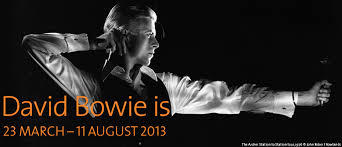It was with some excitement, and a little trepidation, that I took the first train down to London for the David Bowie exhibition at the V&A. To start with I did not have a ticket and hoped that the queue for the daily release of tickets would not be too well formed when I got there (it was not). I also wondered how the curators could pull off an exhibition representing the life and work of such a unique and diverse individual.
On the way down I listened to what, in my opinion, are his key works: those twelve albums of original material from The Man Who Sold The World to Let’s Dance (yes I know that this is contentious but bear with me) on shuffle. It struck me that I could not think of a single artist who had released such a long string of innovative and diverse albums without taking a serious misstep. It also dawned on me as I listened to track after track of fresh sounding music how some artists have based their entire oeuvre on a moment from Bowie’s work. Yet quite the opposite is true of Bowie and this, I thought, will be difficult to encapsulate.
As if to quell my fears my iPod launched into Ziggy Stardust as the doors of the museum opened, and so began 3 hours of pure unadulterated pleasure. The exhibition starts slowly, and quite claustrophobically, as you queue past exhibits of Bowie’s early life and influences accompanied by the mixture of spoken word and music through the obligatory headphones. Gradually, though, the space opens out and I found it great fun walking around the exhibits and listening to different parts of the commentary in a sort of ‘cut and paste’ style (what you listen to is determined by where you are standing). I also loved that as you came into any particular space a particular track would start up in your ears and you could look round to see the accompanying video playing somewhere amongst the exhibits.
It was great to hear all those amazing songs amidst the ephemera of Bowie’s life and career, and I really felt an even stronger connection with his music as a result. I got the sense that his spirit was there through the clothes, lyric sheets, art and influences of his life; and it brought home to me what an important person he is in the culture of the second half of the twentieth century. How he helped us to understand the avant garde and made it accessible without being populist. He understood the culture of his time and where it was going, particularly through his understanding of identity as an increasingly more fluid and fragmented phenomena. He was Ziggy Stardust, Major Tom, the Thin White Duke, the Pierrot etc…, but he was also David Bowie (and originally David Jones) the person, and the rock star. He understood and explored the grey areas and layers of identity which were becoming increasingly more common place in contemporary culture.
He was, then, at the vanguard of change which incorporated punk (although never formally part of the movement he was arguably a huge influence on it) and what came afterwards. You only have to see footage of Britain during the 1977 Jubilee to know that it had a lot more in common with the 1950s than the 1990s, but Bowie was projecting forward not looking back.
The exhibition continued to open out as you move through, taking in his many different personas in varying detail, it but the piece de resistance for me was near the end with a quite amazing area dedicated to the Berlin era, probably the most creative of the exhibition. At the end is a large space with huge screens showing live performances. I thought it was great that there was room to sit around here, and many people clearly did not want to leave the exhibition lest the spell be broken, I certainly did not. A particular highlight for me here was a Top of the Pops performance of The Jean Genie which I found utterly thrilling in this environment, even more so than the seminal Starman appearance, which I had seen in a previous room.
It is hard to do an exhibition such as this justice, and I have missed out much of what there is to see and hear, so I can only conclude by saying what it did for me. It reinforced for me Bowie’s importance as an artist, and widened my knowledge of his influences and how he put them together. It also established much more strongly for me his position as a cultural cipher, especially in (and throughout) the 1970s in the way that he pushed back boundaries and made it ok to be different. In this sense he probably pushed on doors that The Beatles had started to open, and could in many ways be regarded as the natural successor to the Fab Four. But he is also a one-off, a cultural chameleon who understood so much and interpreted it for us and I would struggle to point to anyone who could be regarded as his successor.
Finally, I would recommend this exhibition to anyone who is remotely interested in David Bowie and/or contemporary culture. Not only will help you appreciate how important he is, but also remind you how damn good his music is.
The exhibition continues until 11 August 2013 and, while it is sold out for online sales, 450 tickets are released each day for purchase from the museum from 10am. Get there early to ensure you get your ticket and, most importantly, check the V&A website for updates.
You really will not be disappointed.















No Comment